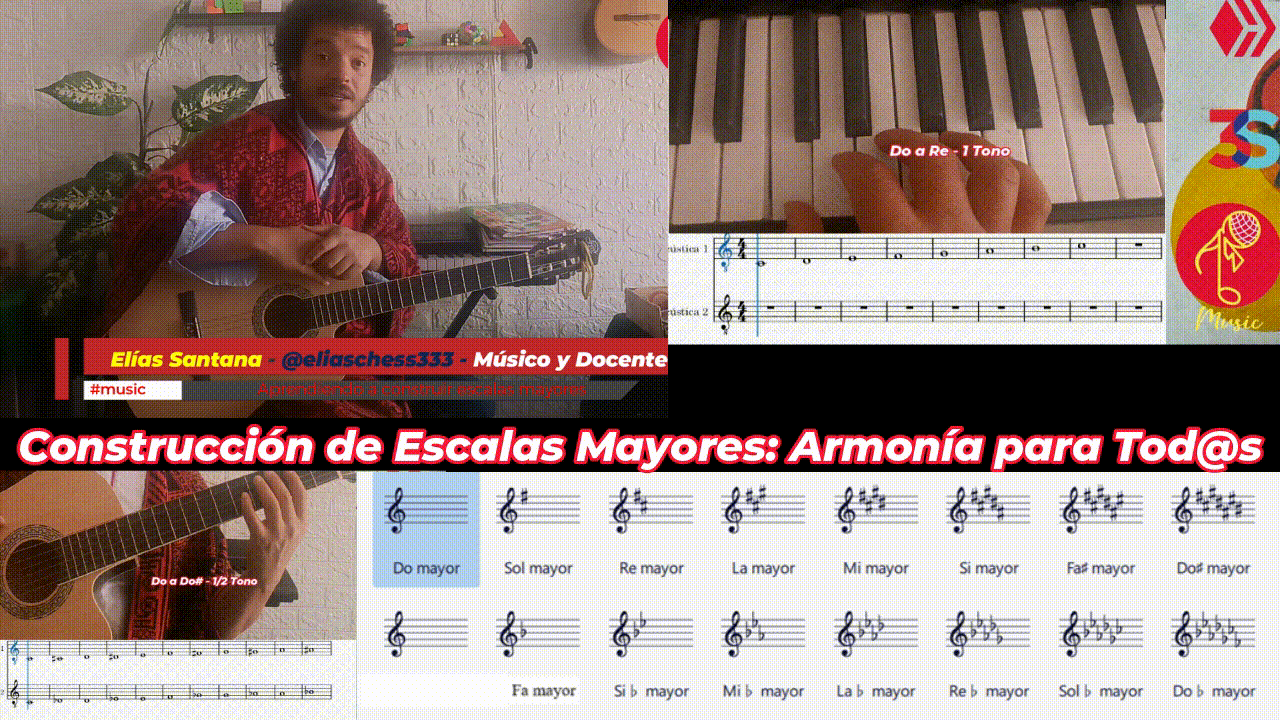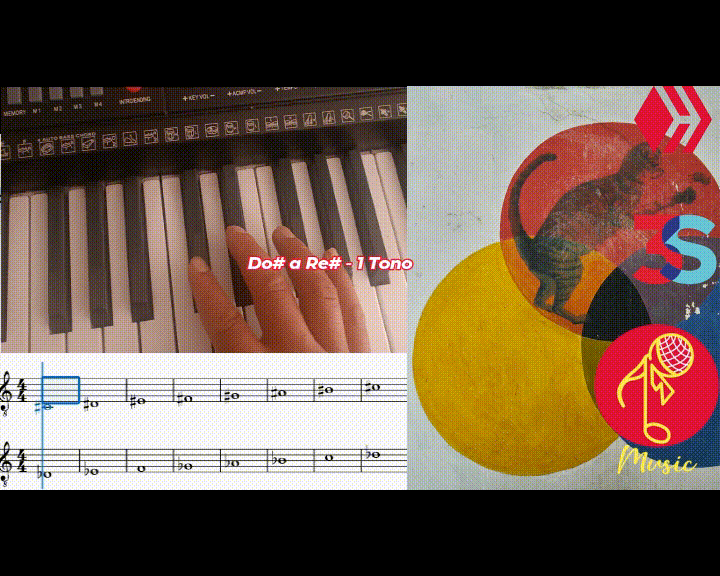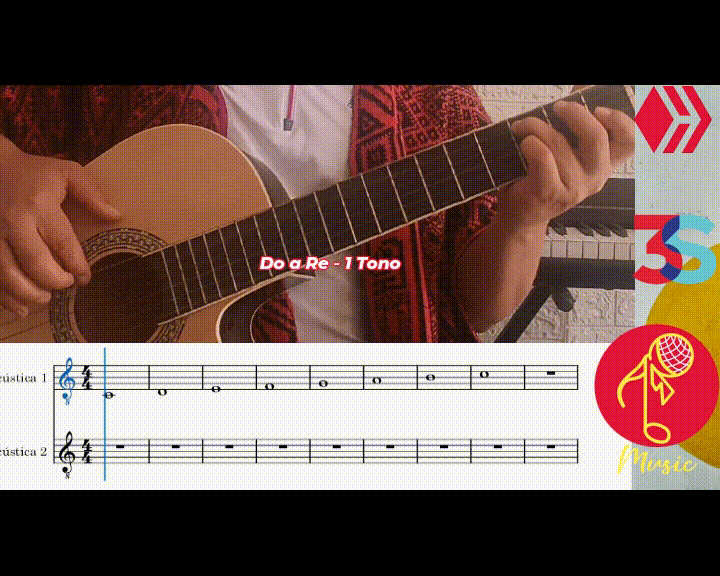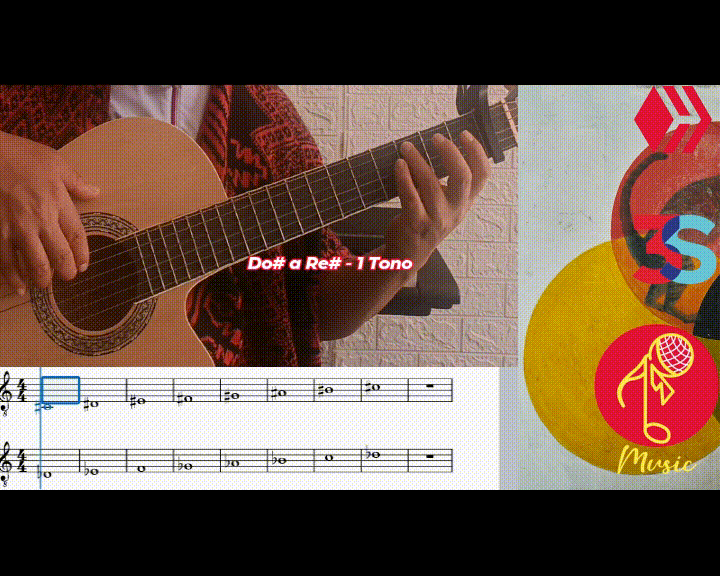Domina todas las escalas mayores con unos simples consejos: armonía para todos // Piano and Guitar
ESPAÑOL
Un gran abrazo a la comunidad musical de HIVE como lo es MUSIC, seguimos con la creación de contenido amparado en la premisa de Armonía para Tod@s, donde comparto consejos que resumen mi proceso de aprendizaje de esta área de la música, como lo es la Armonía. En esta ocasión analizaremos unos interesantes trucos que utilizo para construir todas las escalas mayores.
ENGLISH
A big hug to the musical community of HIVE as it is MUSIC, we continue with the creation of content under the premise of Harmony for All, where I share tips that summarize my learning process in this area of music, such as Harmony. This time we will analyze some interesting tricks that I use to build all the major scales.

Para eso, lo importante es que domines el orden de los sostenidos y los bemoles. A continuación se ilustra el orden de los sostenidos:
For that, the important thing is that you master the order of sharps and flats. The order of sharps is illustrated below:

En ese sentido el orden de los sostenidos es Fa – Do – Sol – Re – La - Mi – Si. Acotando que la escala mayor de Do Mayor, no tiene ninguna alteración:
In this sense, the order of the sharps is F - C - G - D - A - E - B. Note that the major scale of C major has no alteration:

Para construir las demás escalas es necesario comprender el concepto de Semi-Tono, que es la distancia más cercana entre dos notas, para entenderlo mejor vamos a valernos de estas imágenes animadas, donde usamos el piano como referencia:
To build the other scales it is necessary to understand the concept of Semi-Tone, which is the closest distance between two notes, to understand it better we will use these animated images, where we use the piano as a reference:

Y esa lógica de orden de notas se extrapola en la guitarra, simplemente se trata de saber el nombre de la cuerda al aire , y de la nota base de Do y a partir de allí comenzar a con la lógica, como se indica a continuación. haciendo una escala cromática sencilla, sin tomar mucho en cuenta la técnica en el punteo con los dedos:
And that logic of note order is extrapolated to the guitar, it is simply a matter of knowing the name of the string in the air, and the base note of C and from there start with the logic, as indicated below. making a simple chromatic scale, without taking much into account the technique in the plucking with the fingers:

Teniendo claro esto, una escala mayor esta regida por esta regla: Tono -Tono – Medio Tono – Tono – Tono -Tono – Medio Tono, lo cual se ilustra a continuación, usando la escala de Do mayor para hacerlo didáctico, usando el piano como instrumento de referencia:
With this in mind, a major scale is governed by this rule: Tone - Tone - Half Tone - Tone - Tone - Tone - Tone - Half Tone, which is illustrated below, using the C major scale to make it didactic, using the piano as a reference instrument:

Sin embargo, acá te voy a compartir otra forma más rápida de construcción de escalas, por supuesto esta que te mostré es bueno tenerla en cuenta. En esta forma rápida de construcción de escalas, basta como con tomar como referencia el primer sostenido, que corresponde al que está ubicado en la línea de Fa, lo que indica que dentro de esa escala todos los Fa serán sostenidos, teniendo claro esto buscamos el semitono superior a ese Fa#, que viene siendo Sol, por lo tanto la escala de Sol Mayor tiene un Fa#. Ahora bien, siguiendo el orden de los sostenidos ¿Qué escala tiene Fa# y Do#? Tomamos como referencia la última alteración, en este caso Do#, entonces el semitono superior es Re, lo que significa que las alteraciones de la escala de Re Mayor son Fa# y Do#. Te reto a que hagas estos análisis con el resto de las escalas, de igual manera acá te dejo un resumen:
However, here I am going to share with you another quicker way to build scales, of course this one I showed you is good to keep in mind. In this quick way of scale construction, it is enough to take as a reference the first sharp, which corresponds to the one located on the F line, which indicates that within that scale all the F's will be sharps, having this clear we look for the semitone above that F#, which is G, therefore the G major scale has an F#. Now, following the order of the sharps, which scale has F# and C#? We take as reference the last accidental, in this case C#, then the upper semitone is D, which means that the accidentals of the D major scale are F# and C#. I challenge you to do this analysis with the rest of the scales, likewise here is a summary:

Noten que el caso donde están presentes todos los sostenidos, en el orden de presentación el último sostenido esta asociado a Si#, lo cual en términos prácticos es Do, y el semitono superior a Do es Do#, entonces la escala de Do # mayor lleva todas las alteraciones. Y ahora de pronto se preguntarán ¿por qué no aparece la escala de Fa, la escala de Re#, escala de Sol#, y allí le damos la bienvenida a las escalas con bemoles., Y el orden de los bemoles coincide con el de los sostenidos pero en sentido contrario.
Notice that in the case where all the sharps are present, in the order of presentation the last sharp is associated with B#, which in practical terms is C, and the semitone above C is C#, so the C# major scale carries all the accidentals. And now suddenly you may ask why doesn't the F scale appear, the D# scale, the G# scale, and there we welcome the scales with flats, and the order of the flats coincides with the order of the sharps but in the opposite direction.

Y acá para construir la escala, lo primero que tienes que tener claro es la escala base que tiene un Si bemol, representada por la escala de Fa Mayor:
And here to build the scale, the first thing you have to be clear about is the base scale that has a B flat, represented by the scale of F major:

El nombre de las demás escalas con bemoles vendría dado por el penúltimo bemol, por ejemplo si tenemos el orden de bemoles: Si-Mi-LA, el penúltimo bemol es Mi, entonces la escala de Mib mayor tiene estas alteraciones , acá un resume de todas las escalas que surgen, y tambien te dejo como reto que construyas cada una de ellas.
The name of the other scales with flats would be given by the penultimate flat, for example if we have the order of flats: B-Mi-LA, the penultimate flat is E, then the scale of Eb major has these accidentals, here is a summary of all the scales that arise, and I also leave you as a challenge to build each of them.

Es interesante este hecho: Do# es equivalente a Reb, sin embargo por algo son nombres diferentes, incluso diferente forma de escribir, pero a nivel de sonido es lo mismo, me gustaría saber tu opinión en torno a este punto:
It is interesting this fact: C# is equivalent to Reb, however for some reason they are different names, even different spelling, but at the sound level is the same, I would like to know your opinion on this point:

Para la ejecución de esta escala en la guitarra primero te presento Do Mayor, estoy con la intención de que veas la funcionalidad de CAPOTRASTE
For the execution of this guitar slab, I first introduce you to C Major, with the intention of showing you the functionality of CAPOTRASTE.

Ahora usando CAPOTRASTE en el primer traste, subo medio tono, porque en esencia avanzar en cada traste esta marcado por la distancia de medio tono. Al subir ese medio tono logro la escala de Do# Mayor, con los mismos movimientos de Do Mayor:
Now using CAPOTRASTE on the first fret, I go up half a tone, because in essence advancing on each fret is marked by the half tone distance. By raising that half tone I achieve the C# Major scale, with the same movements of C Major:

En una próxima entrega estaré profundizando en el uso de Capotraste y la transportación electrónica con el teclado así como también armonizaremos la escala de Lab Mayor y contrastaremos con Sol# Mayor. Si quieres profundizar en el proceso de armonización de la escala de Do Mayor, te comparto las siguientes entregas.
El cómo yo he entendido la armonía musical. Entrega 01: una escala es más que una escala El cómo yo he entendido la armonía musical. Entrega 02: comprendiendo los acordes mayores y menores El cómo yo he entendido la armonía musical. Entrega 03: desentrañando los secretos de las séptimas. Caso 01: escala menor eólica El cómo yo he entendido la armonía musical. Entrega 04: desentrañando los secretos de las séptimas. Caso 02: escala menor melódica y armónicaEl cómo yo he entendido la armonía musical. Entrega 05: desentrañando los secretos de las séptimas - Caso 03 "acordes disminuidos y semi -disminuidos"
Espero estos contenidos expuestos hayan sido de tu agrado y utilidad. Nos leemos y escuchamos en una próxima oportunidad. Escribió para ustedes:
@eliaschess333
In a next installment I will be deepening in the use of Capotraste and the electronic transposition with the keyboard as well as harmonizing the scale of Lab Major and contrasting it with G# Major. If you want to go deeper into the harmonization process of the C Major scale, I will share with you the next installments.
How I have understood musical harmony. Part 01: A scale is more than a scale.
How I have understood musical harmony. Part 02: understanding major and minor chords.
How I have understood musical harmony. Part 03: unraveling the secrets of the sevenths. Case 01: Aeolian minor scale
How I have understood musical harmony. Part 04: unraveling the secrets of the sevenths. Case 02: melodic and harmonic minor scale.How I have understood musical harmony. Part 05: unraveling the secrets of the sevenths - Case 03 “diminished and semi-diminished chords"
I hope these contents have been of your liking and usefulness. We will read and listen to each other in the next opportunity. Written for you:
@eliaschess333
| @eliaschess333 - Director del Video | @eliaschess333- Video Director | |||
|---|---|---|---|---|
| Las tomas estuvieron a cargo del director usando trípode de apoyo en los casos necesarios | Shots were taken by the director using tripod support when necessary. | |||
| Agradecimientos a Servio Romero, por las conversaciones sostenidas en torno a las bases de la armonía musical | Thanks to Servio Romero, for the conversations held on the basis of musical harmony. | |||
| El video y las imágenes animadas fueron editados con Filmora 11 | The video and animated images were edited with Filmora 11. | |||
| El logo de MUSIC es cortesía de la comunidad | MUSIC logo is courtesy of the community | |||
| Los logos de HIVE, 3SPEAK cortesía Proyecto ALIENTO | HIVE, 3SPEAK logos courtesy of ALIENTO Project | |||
| El traductor empleado es DeepL Translator | The translator used is DeepL Translator | |||
| Los símbolos musicales y fragmentos de partituras presentadas fueron realizados con el programa MuseScore 4 | The musical symbols and score excerpts presented were created with MuseScore 4 | |||
| Los logos empleados de redes sociales son de uso libre, a continuación los enlaces: InstagramYoutubeTwitterTikTokFacebook | The logos used in social networks are free to use, here are the links: InstagramYoutubeTwitterTikTokFacebook |
 |  |  |  |  |
|---|
▶️ 3Speak
0
0
0.000
Me mareé aaaaah necesito ver esto más lento y para mí solo jja saludos maestro
Saludos estimado @elisonr13 gracias por el feedback. Míralo despacio, la parte escrita apoya el vídeo, espero te sea de mucha utilidad!! Saludos!!